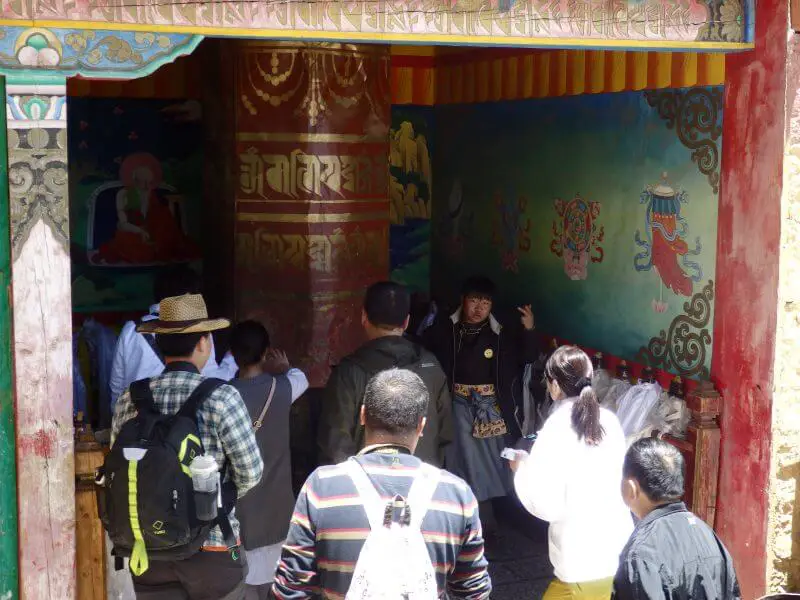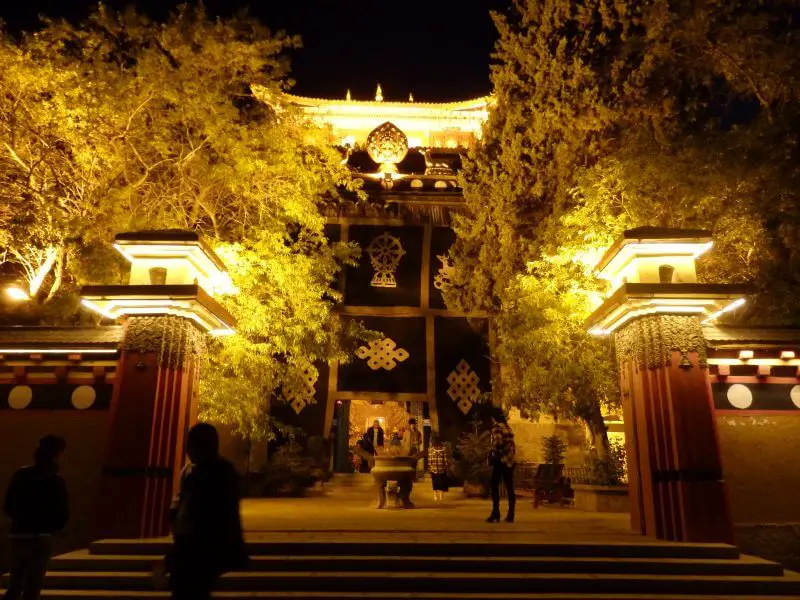How I nearly died- and survived in the Tibetan town of Gyalthang, popularly romanticised as Shangri-La, 3,200m above sea level, surrounded by lush grasslands and soaring mountains.
Day 0: Journey to the fabled city of Shangri-La
Accounts of Shangrila (or Zhongdian, original name before a re-branding to promote tourism) tend to describe it as a fairy tale like place; romantic yet exotic at the same time. While such stories may feel somewhat over romanticised, it wasn’t hard to see how they may have been conjured. The landscape changed dramatically as we peeled away from Lijiang and climbed further up into the mountains. At times it felt like we were almost in the clouds. A friend had joined me just before this at Lijiang and we were to be exploring northern Yunnan for the two weeks. I was really fortunate to have him in Shangri-La, as the circumstances were to turn out later.



First impressions of Shangri-La
After another few hours on the bus, almost another 200km later, we alighted just outside the old town and began our search for the hostel. It soon became apparent that Shangri-La was nothing like any of the earlier Chinese cities in my earlier stops. Mandarin almost felt like a foreign language here; They’re mostly able to speak Mandarin but sounded noticeably different from people from the earlier cities. The population was mostly Tibetan. Certainly a refreshing change of environment after almost 2 weeks in cities with seemingly much more identical cultural backgrounds (though still quite a vibrant mix). The architecture and atmosphere felt distinctively different too, and at times I wondered if I were still in China.

We got a little disoriented and asked a guy who was dressed like a cowboy for directions. Turns out he wasn’t a local but was here to start a business. Had a nice short chat, and he gave us directions to our hostel, not too far away from where were at the Moonlight Square. I doubt he was moonlighting though.



Yak Butter Tea Conversations
At the hostel, we met a traveler from another part of China who had just arrived, and went for dinner together. We had a nice cultural exchange over dinner, though I thought some of his perceptions of the world, as a Chinese citizen, felt a little scary.

After hearing so much about yak butter tea, I was excited to finally be able to try it in Shangrila. There were fake ones around, but we were fortunate to find a restaurant opened by a very friendly Tibetan guy selling Tibetan food. The tea comes in quite a huge kettle and is probably enough for 5 or more people. The first few cups were interesting, but the pungent smell was soon too overpowering and I found it hard to appreciate the rest of the pot. I’d still recommend it to the adventurous though.

At 3,200m high, agriculture is hard and most fruits are brought in from the south, resulting in generally pricier fruits (and other foodstuff). Fortunately I bought these just before leaving Lijiang, where it was considerably cheaper (though not cheapest). I savoured the last bits of fresh fruit I was to have for the next few days.

Day ?: A bout of altitude sickness
Not sure if it was the copious amounts of yak butter tea I had after dinner (which was suppose to help prevent), or something else, but I woke up in the middle of the night in cold sweat, with a mind numbing headache, and feeling incredibly nauseous and giddy. I had spent the past 2 weeks in Yunnan, over 2,000m above sea level, without much problem, but that night, at 3,200, altitude sickness finally struck. It was scary, having to rush back and forth to the toilet and puking my guts out. Felt like it was my guts. It was too early to head out for help, yet I couldn’t fall asleep with that headache and nausea.
Getting help
Morning finally broke after what seemed like the longest night ever. With what little strength I had left, made it to my friend’s bunk to ask him for help in getting to some clinic. Made it to the hospital and put on drip. The nurse said it would take 20 mins. After almost 20 mins, the fluid bag was still almost full, and I noticed my hand was swelling up. Turned out the nurse had missed the vein. Oh well, another 20 mins. And really thankful for my friend who just sat there waiting for me. It was the first time on drip and I was surprised by what a bag of that stuff can do.
Felt much better after that but spent the rest of the day resting, while my friend explored the old town. Really glad my friend did some exploring that day, as I would have felt really horrible if he had stayed in because of me.
It was probably one of the most terrifying experiences of my 50 days on the road, even more than being alone in the woods in Siberia. I was prepared to cancel my 4 day hike in the mountains just a few days later, but the rate at which my body recovered surprised me. After all that trouble, it was just a little hiccup in the bigger adventure.
Day 2: Ganden Sumtseling Monastery and Shangri-La Old Town
Felt good enough to explore the next day and made a trip to the Ganden Sumtseling Monastery. It’s also known as the Songzanlin Monastery or the Little Potala Palace. After that bout of altitude sickness, I don’t think I’d be going to Lhasa any time soon and this was a pretty decent compromise.
There were mud houses beside the hostel/ hotel. Interesting as I’ve never seen houses made of mud before.

We started the day at where mine ended two days ago, at the friendly Tibetan restaurant.

Ganden Sumtseling Monastery
The monastery entrance was a short bus ride out of town. It’s unlikely to miss the stop, as the bus travels into areas off limits to tourists beyond the monastery so staff will usher tourists out. After purchasing a ticket( ¥115), a shuttle bus took us from the ticketing building to the monastery itself (quite a distance away).

The monastery had recently been restored and was in good shape (it had better be, with that admission price). Photography was not allowed inside prayer buildings thus most pictures are from the outside. Really interesting place to explore for a few hours, and I’d definitely recommend it to anyone visiting Shangri-la. Or maybe unless you’re going to the actual Potala Palace. There were guided tours available for no extra charge at certain timings. We were a little early for the next tour so we wandered for awhile before joining the scheduled tour.














Beyond Ganden Sumtseling Monastery
It felt like a few hours out of this world, before bring brought back down to earth. More details on visiting the monastery can be found here and more on its history on Wikipedia here. We spent a little more time exploring the gardens outside the monastery before heading back to the city.



Shangri-La Old Town
Back in the city, we went exploring Shangri-La old town.

Large parts of the old town was being rebuilt following a massive fire over a year ago that destroyed much of it. Nevertheless, the charm of the old town remains.



At the the Moonlight Square (Yue Guang Guang Chang), locals engage in some sort of traditional dance every night. Quite a sight to watch, as I seldom see such large groups of people dancing in Singapore.

Beside the square, there was a stairs leading to the Golden Temple, on a hill overlooking Shangri-La. Felt like there was a mix of styles in the design of the temple.




Day 3: Continuing the adventure with hiking in the mountains to Yubeng
It was time for us to leave Shangrila and head towards the mythical village of Yubeng, deep within the Yunnan/Tibetan mountains. Glad I recovered sufficiently to make the trip by then.




And that’s it from the little lost paradise. Lots of other amazing natural wonders near Shangri-La, such as Pudacuo National Park, Baishuitai Water Terrace, Napa Lake and more, but unfortunately not on this trip, maybe next time. Next, to Yubeng.
Shangri-La (Zhongdian) Budget
- Actual travel dates: 25 May 2015 – 28 May 2015
- Accommodation: ¥92(~S$20 for 3 nights)
- Attractions: ¥115(~S$25)
- Food: ¥60(~S$13) (I don’t remember eating anything the day I was sick, and some Tibetan guy I was trying to ask something from got us dinner for one of the nights. Amazing hospitality, and also why the amount on food was so low)
- Transport (excl bus to Deqin): ¥3(~S$0.65)
- Bus to Deqin: ¥67 (~S$15)
- Total: ¥348 (~S$76) (excludes medical bills covered by insurance, but I don’t think it was much)



